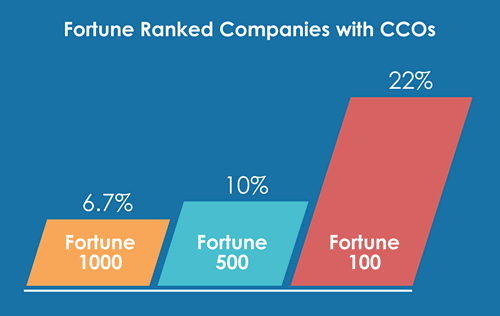
According to the 2014 Chief Customer Officer study by the CCO Council, 22% of Fortune 100 companies has a Chief Customer Officer on board. While there are different views on the role and the data as such matter less, it’s another sign that organizations – try to – become more customer-centric.
Customer-centricity is everything. And the customer experience is at the heart of business value. Customer-centricity is becoming more than a vague promise of CRM vendors and more than a term (and often false promise) companies use to tell the world (and thus their customers) how they always put people first. The Chief Customer Officer should be seen in that context, even if the rise of the role, let alone the role as such, goes back further in time as you’ll discover.

After far too long, things are starting to change, although there still is a long road ahead, filled with stumbling blocks such as silos, wrong mentalities and disconnected systems and processes. Nevertheless, many companies are working hard to implement a more customer-focused and cross-divisional approach and are implementing company-wide ROMI-programs and holistic customer-centric strategies with more attention for the customer experience.
Doing this is not easy; it requires a different way of thinking and working but often also a huge shift in the corporate way of thinking, especially at the top. Regardless of how tough it may be: the customer is key in modern marketing and management thinking. And it’s about time. Do companies even have the choice in this digital and ‘social’ era?
How and why the Chief Customer Officer came into the picture
If the customer is key, then don’t we need some kind of ‘customer supervisor’ in the company? And someone who is responsible for the customer experience? The question isn’t new. In 2004, Bruce Temkin (back then at Forrester) wrote a report, showing the need for a more centralized customer experience approach. He found 24% of large organizations he talked with had someone who was in charge of the customer experience. In 2003, it was 22%.

Everyone recognized the need for that more central approach and there were debates about that famous role/function, among others regarding the division it belonged to. Furthermore, opinions were different, depending on customer service channel. Silos indeed. It was just a logical evolution that went hand in hand with the advent of new technologies and changing expectations. Contact centers, back then call centers, weren’t able to connect the customer service dots around the customer (with “culture” and a single customer view being a key challenge).
Furthermore, as companies invested in CRM, they also felt the increasing need to offer support via more channels as customer behavior started changing and they weren’t too satisfied with early CRM projects. And, last but not least, the way customers were handled in a service context was totally chaotic as became crystal clear in research.
Bring in the CCO
The Chief Customer Officer (CCO) role started to pop up in 2008. In a 2009 survey of predictive analytics specialist SPSS (update: now IBM SPSS), already more than two-thirds of surveyed marketing professionals back then believed that the company needed a Chief Customer Officer or CCO. In fact: over half of the companies, where the respondents worked, had one according to the report. That seems to be in stark contrast with the more recent data from the CCO Council I mentioned earlier.
A question that remained in the beginning, however, is whether the CCO should belong to a specific department or have a more global cross-divisional function that overlaps departments such as marketing, sales and customer service? Quite funny really as the exact same questions were already asked in 2003 and even before. It gets even more funny – or sad – if you know that today many organizations are not structured or organized around the customer, let alone have someone overseeing it all.

39% of the participants in the SPSS survey believed that the CCO should belong to the marketing department. Same phenomenon in 2004. However, one-fourth of the respondents felt he should have a management position. And that was a big change.
What are the main responsibilities of the CCO? According to the respondents to the SPSS survey it’s customer service, followed by reducing customer churn and gaining new customers. Although the CCO sometimes goes by other names, the CCO Council has a clear definition: “an executive who provides the comprehensive and authoritative view of the customer and creates corporate and customer strategy at the highest levels of the company to maximize customer acquisition, retention, and profitability.”
What I personally still miss a bit is the customer experience. But that’s another story. As is the fact that everyone needs to be a customer champion today.
More about the Chief Customer Officer:
- Check out the website of the Chief Customer Office Council.
- Read the book, “Chief Customer Officer : Getting Past Lip Service to Passionate Action” by Jeanne Bliss.
Note: originally pusblished in 2009 and updated with new data in 2014.

